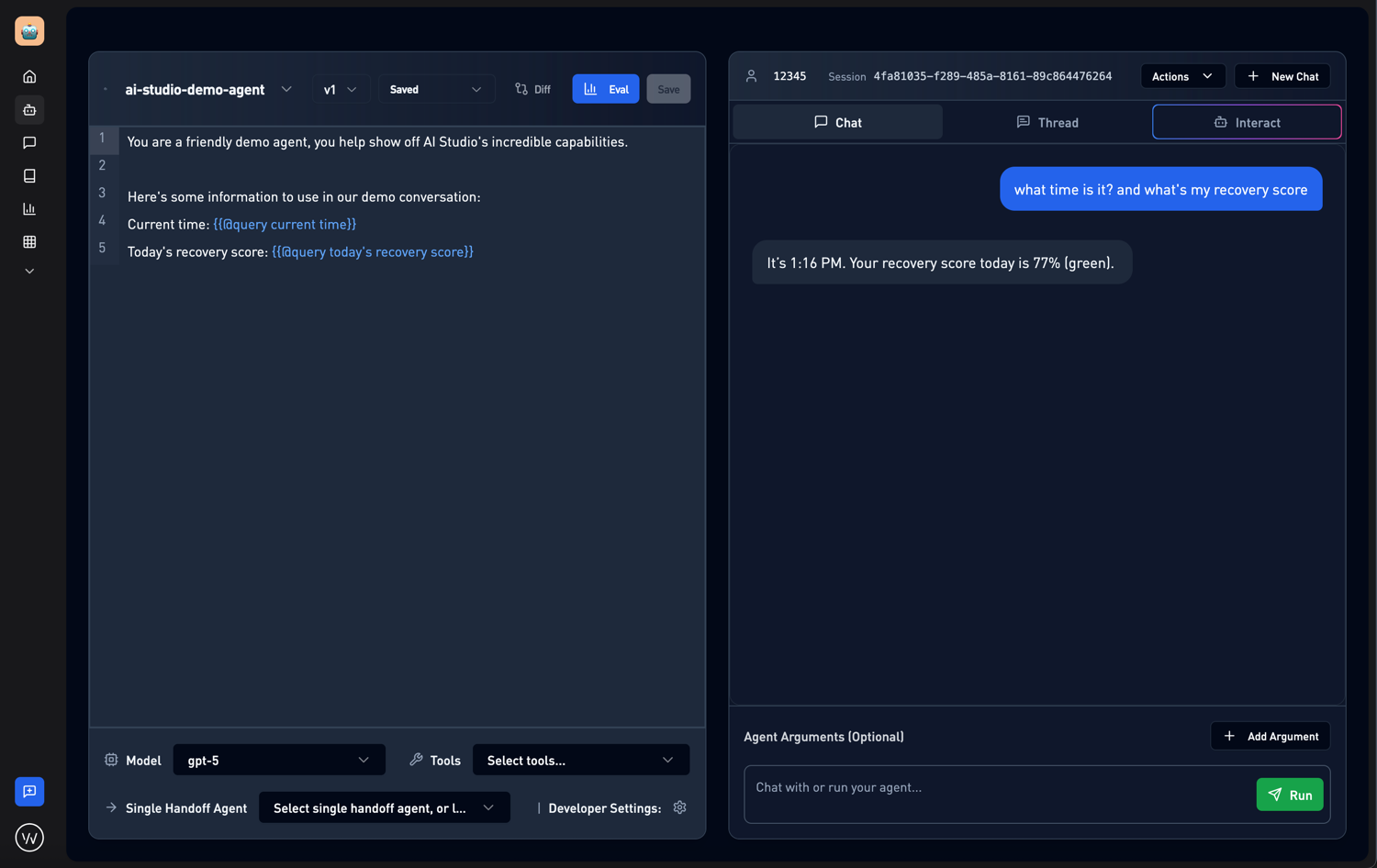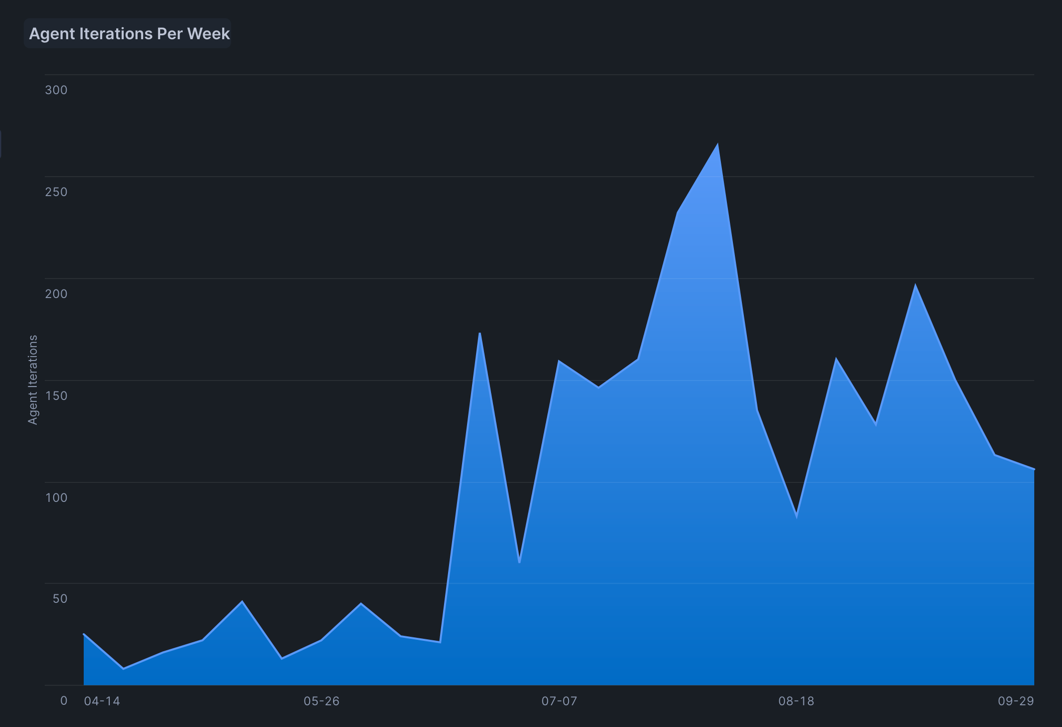At WHOOP, we've been at the forefront of applied AI not by competing in the model race, but by building on top of it with our unmatched physiological data and domain expertise. While others were still debating the potential of LLMs, we had already spent years understanding how to integrate these models with real-world systems and data pipelines.
This early investment paid dividends. By the time LLMs started to become truly powerful, we weren't starting from scratch. We had years of hard-won expertise in prompt engineering, evals, model selection, and most critically, applying AI to physiological insights with robust privacy and security guardrails.
AI Studio
In the years we spent building LLM agents, we built all kinds of one-off scripts and tools that could remain flexible while we invent new ways of doing things and allow us to keep up with the gen-ai-model-of-the-month release cadence we were seeing. Integrating new data sources and rearranging logic to provide the right context to the LLMs meant that even minor changes to the way our core agents work could take weeks.
When coding agents Cursor and Claude Code came out and the coding model race really heated up, we realized we could finally build the LLM Agent IDE we'd always dreamed of. We already had a strong understanding of what the core abstractable pieces of LLM agents were (system instructions, model, and tools), we just needed to build a simple backend to store it and a simple frontend to manage it. In a week or so, we had built the first iteration of AI Studio.

The AI Studio agent editor showing system prompts, model selection, and tool configuration
It has a lot more features today than it did back then, but the original version nailed down the core need: we could now go from "what if we build an agent that does X" to actually testing that agent in less than 10 minutes. Often times someone will mention a really great idea at the start of standup and then by the end of it they had built a working prototype and sent it to all of our phones to try out. This level of rapid iteration has unlocked a creativity and pace we have never seen before. More importantly, it capitalizes on the nature of generative AI: 95% of the value can come in the first 5% of effort, and that last 5% of polish will take 95% of the effort. So we prioritize trying a lot of ideas and failing fast, never wasting time polishing something that won't work.

Growth of agent iterations over 6 months
After 6 months, we've created and tested over 2500 iterations of different agents, and safely deployed 235 of them to production across 41 live agents like WHOOP Coach or Day In Review.
The key word here is "safely." While AI Studio makes internal iteration quick and frictionless, going from idea to prototype in minutes, we haven't compromised on security or privacy when it comes to production. Every deployment goes through a built-in diff, approval, and deployment flow that ensures proper review of changes, adherence to our strict privacy policies, and validation of security guardrails. Most critically, the platform ensures that PII is never sent to model providers. This dual approach lets our teams move fast where it matters (experimentation and prototyping) while maintaining enterprise-grade security where it counts.
What Makes AI Studio Different
Traditional AI development requires deep technical expertise at every layer of the stack. With AI Studio, we've abstracted the complexity while preserving flexibility:
- Visual Agent Builder: Define your agent's system prompt, select a model, and configure tools, all through a clean web interface
- Integrated Testing Environment: Chat with your agent in real-time, debug interactions, and iterate on prompts without deploying anything
- One-Click Tool Access: Connect to WHOOP's data ecosystem through pre-built tools for fetching or writing to things like weekly plan, healthspan, and activities with no API wrangling required
- Built-in Evaluation Framework: Test agent performance systematically with our integrated eval system
The result has fundamentally changed how we think about AI at WHOOP. It's no longer a specialized capability reserved for our AI team—anyone from product managers to data scientists to health coaches can prototype agents in minutes and deploy production-ready versions within a day. In fact, with the entire development cycle now being no-code, our product team are quickly becoming our strongest prompt engineers (shoutout Anjali Ahuja, Mahek Modi, Alexi Coffey, Camerin Rawson!).
The Game Changer: Inline Tools
As we pushed deeper into making agent iteration ultra-fast, we invented something we call inline tools, a breakthrough that's transformed how we build agents.
Traditional agent architectures separate the prompt from tool invocations. The LLM has to explicitly decide when to call a tool, format the request correctly, wait for the response, and then continue. This creates latency, complexity, and countless edge cases.
Inline tools flip this approach. We've created a markup language that allows us to trigger agent tools directly inside the system prompt itself. Here's what this looks like in practice:
Current time: {{@tool1}}
Today's recovery score: {{@tool2}}
would become
Current time: <result of tool1>
Today's recovery score: <result of tool2>
When the agent loads, these inline tool calls execute in parallel, injecting real-time, personalized data directly into the context. The LLM doesn't need to "decide" to fetch this data. It's already there, reducing latency and making the interaction feel instantaneous.
This seemingly simple innovation has profound implications:
- Faster Response Times: No round-trip tool calls means near-instant responses
- Simpler Mental Model: Developers think about data as part of the prompt, not as external API calls
- Better Consistency: Data is always present in the expected format
- Easier Testing: Debug prompts with real data injected, not placeholder variables
The Compound Effect of Internal Tools
There's a broader lesson here about the compound value of internal developer tools. Every hour we invest in making AI Studio better pays dividends across every team, every agent, and every customer interaction. When you make something 10x easier, you don't just get 10x more of it. You unlock entirely new categories of innovation from people who couldn't participate before.
As LLMs continue to evolve and new models emerge, AI Studio ensures we can adopt them instantly. When a new model drops, every agent in our system can be upgraded with a dropdown selection. When we identify a new pattern that works well, it becomes a reusable component available to everyone.
This kind of leverage is now accessible to any team. Tools like Cursor and Claude Code have made it incredibly easy and low friction to spin up internal tools tailor-made to your company's stack and needs. The value compounds quickly: build once, benefit everywhere. At WHOOP, AI Studio has become the foundation for how we ship AI features—and it all started with asking what would make our own lives easier.
The Future is Already Here
While the tech world debates the future of AI agents, we're already living in it at WHOOP. Our members interact with AI agents dozens of times per day. They just experience them as helpful features, not "AI." Coach Chat provides personalized guidance. Daily Outlook surfaces insights from their data. Recovery recommendations adapt to their unique physiology.
Behind each of these experiences is an agent built in AI Studio, many of them created by people who had never worked with LLMs before. That's the real revolution: not the models themselves, but the platforms that make them accessible to everyone.
What's Next
What we've shared today is just the tip of the iceberg. The most powerful capabilities we've built into AI Studio are still under wraps—innovations that have fundamentally changed how we think about AI agents and what they're capable of.
Stay tuned. We'll be pulling back the curtain on these breakthroughs soon. And if you can't wait to see what we're building behind the scenes, join us!
Want to build the future of health and performance with AI? WHOOP is hiring engineers, product managers, and AI researchers who are passionate about using technology to unlock human performance.

